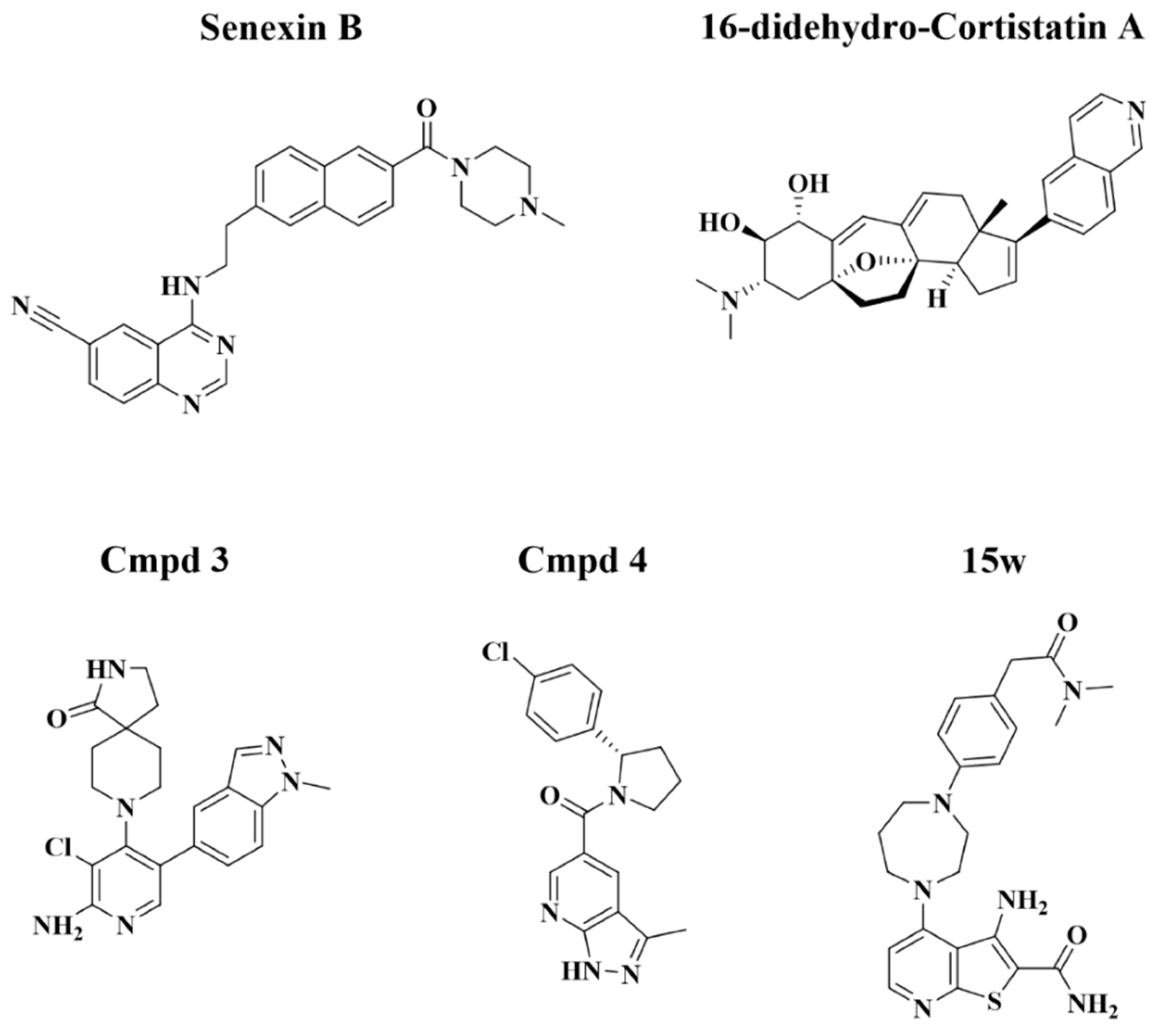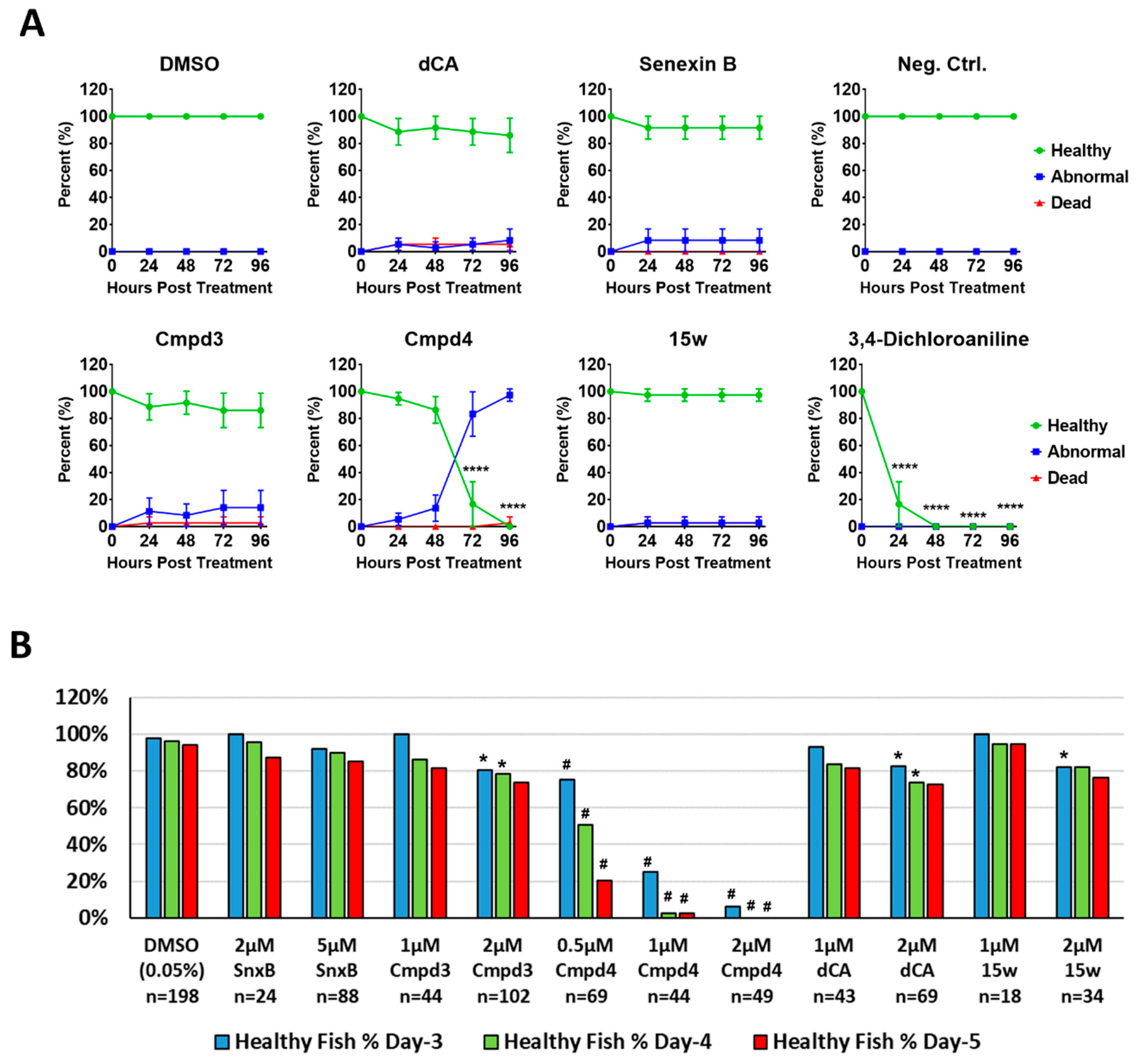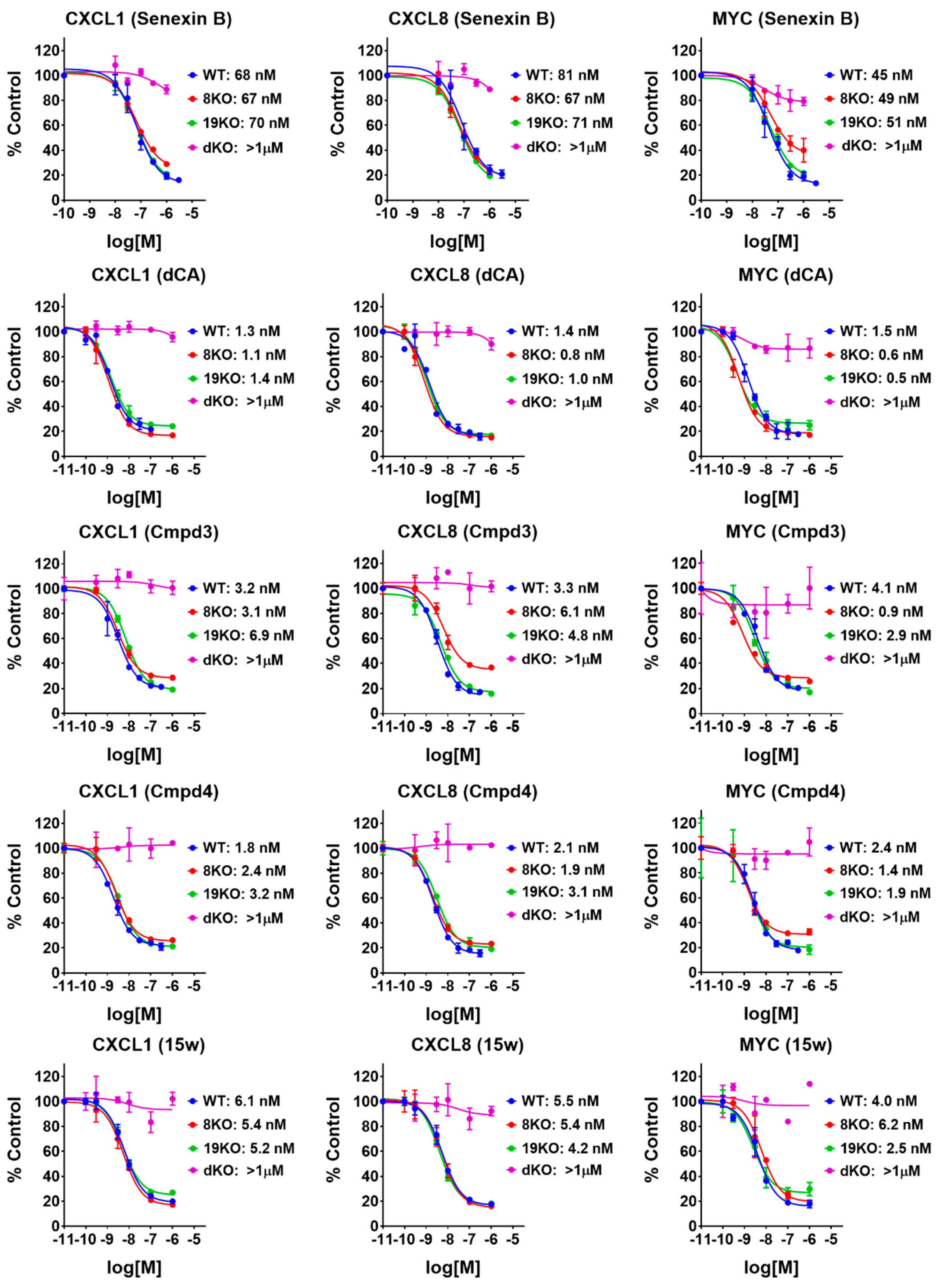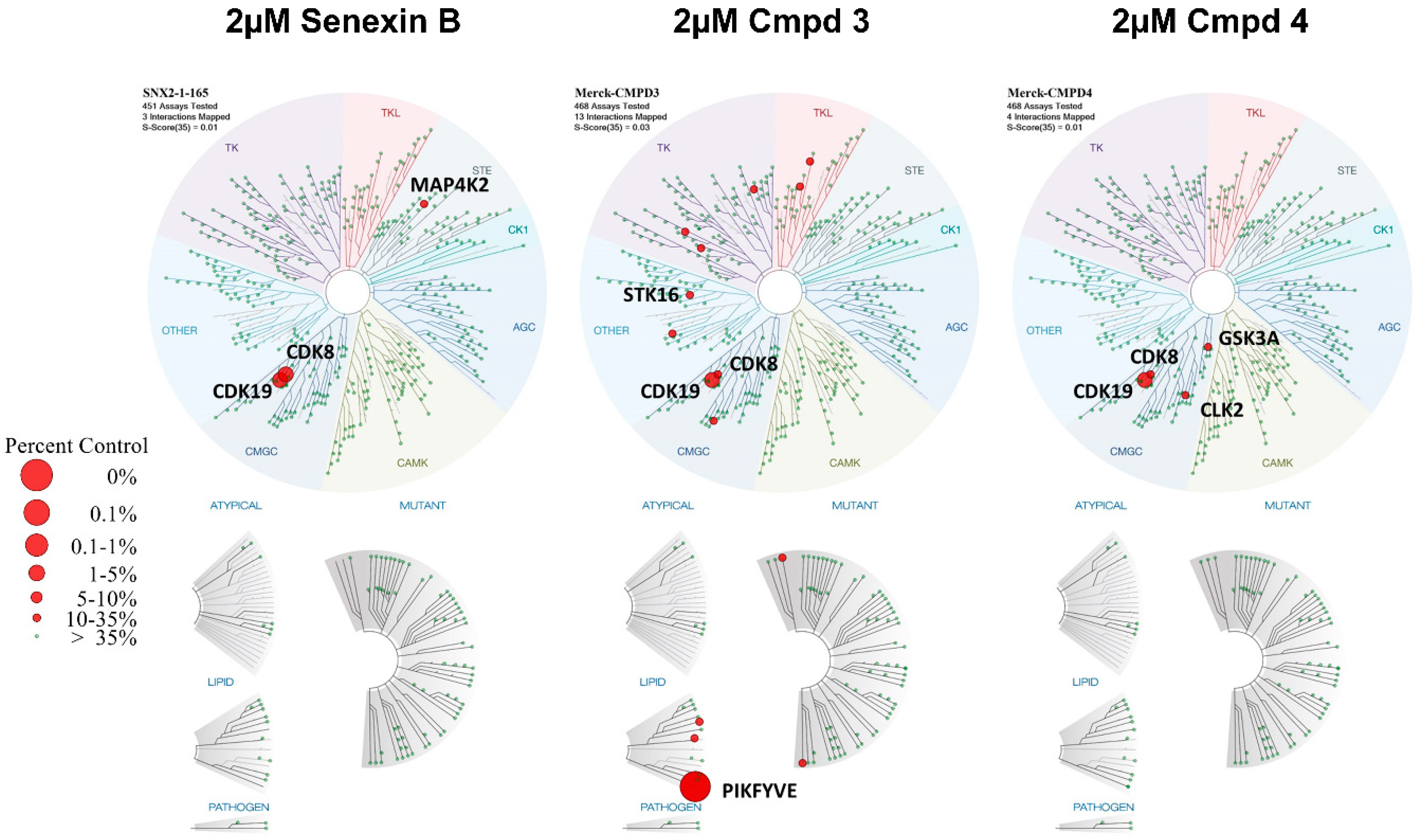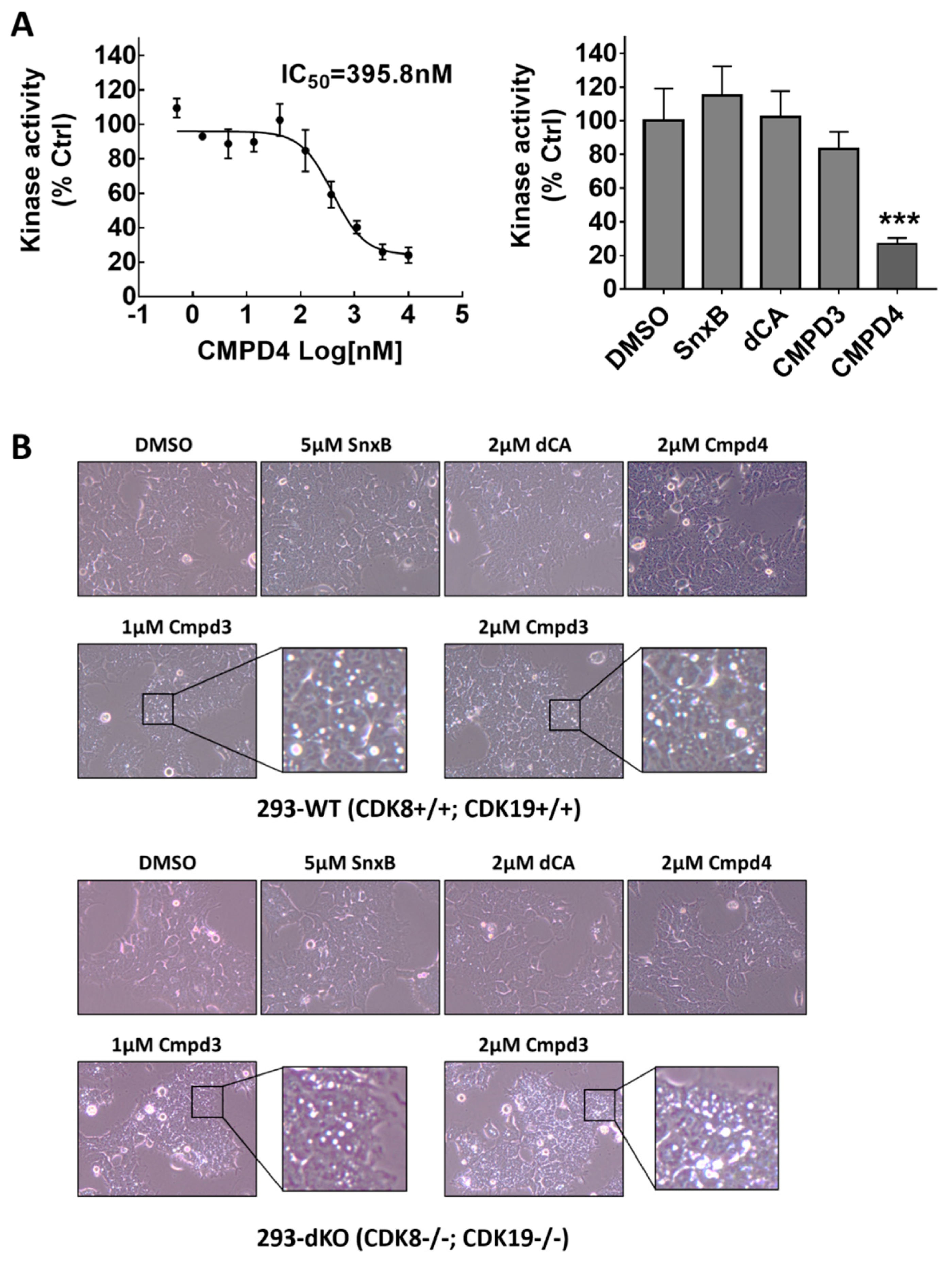1. Introduction
The Mediator kinases, CDK8 and its closely related paralog CDK19, have become active targets for drug development, primarily for oncological applications [
1]. Unlike better-known members of the cyclin-dependent kinase (CDK) family, such as CDK1, CDK2 and CDK4/6, CDK8/19 do not mediate cell cycle progression but are only involved in transcription [
2,
3]. Furthermore, in contrast to the best-known transcriptional CDKs, such as CDK7 and CDK9, CDK8/19 activity is not required for overall transcription, and CDK8 or CDK19 depletion do not inhibit proliferation of most cell types [
4]. Instead, CDK8/19 regulate transcription in a selective gene-specific context, primarily enhancing the induction of silent genes as they become activated by various transcription factors [
5]. This unique function defines CDK8/19 as mediators of transcriptional reprogramming, a process that plays a key role in the plasticity of tumor cells [
3,
5], allowing these cells to colonize heterologous environment (metastasis) and survive adverse conditions (drug resistance). Indeed, CDK8 knockdown or CDK8/19 inhibition in colon cancer selectively suppressed the growth of metastatic but not primary tumors [
6], suppressed invasive growth by counteracting epithelial-mesenchymal transition [
7], interfered with damage-induced secretion of proteins enhancing tumor growth and drug resistance [
8], primarily through an effect on NFκB-induced transcription [
5], and suppressed the development of resistance to estrogen deprivation in estrogen-receptor positive breast cancers [
9]. The ability of CDK8/19 inhibitors to suppress metastatic growth and to prevent the development of therapy resistance suggests a potentially transformative potential for combinations of these inhibitors with various cancer therapeutic regimens.
A number of small-molecule CDK8/19 inhibitors have been developed [
1]; such inhibitors showed in vivo therapeutic effects in leukemia [
10,
11], lung [
8], breast [
9], colon [
6] and prostate cancers [
12]. Notably, these effects were associated with no apparent systemic toxicity [
6,
9,
10,
11]. The first clinical trials of Mediator kinase inhibitors have been initiated in estrogen-receptor positive breast cancers (
ClinicalTrials.gov Identifier: NCT03065010) and acute myeloid leukemia (AML) (
ClinicalTrials.gov Identifier: NCT04021368).
Despite the encouraging results with several CDK8/19 inhibitors, a different picture emerged from a report by Clarke et al. [
13]. In this and preceding studies [
14,
15,
16], authors developed two chemically distinct series of small molecule inhibitors with reportedly high selectivity and potency for CDK8/19, starting from cell-based assays for β-catenin inhibition. The two most advanced compounds in both series, Cmpd3 (CCT251921) and Cmpd4 (MSC2530818), were then tested in a battery of in vitro and in vivo assays. Doses of these compounds used for in vivo studies were selected to provide sustained inhibition of the phosphorylation of transcription factor STAT1 at S727 in the treated tumors, which was assumed by the authors to be a pharmacodynamic (PD) marker of CDK8/19 inhibition. Although these compounds showed efficacy in colon cancer and leukemia mouse xenograft models, the authors also noted detectable weight loss in mice. When Cmpd3 and Cmpd4 were tested in rats and dogs, they yielded multiple and striking toxicities, including lethality, which were overlapping but not identical between the two compounds. The authors concluded that the observed toxicities were on-target effects of CDK8/19 inhibition and even suggested that CDK8/19 inhibition should be screened against in the development of future CDK inhibitors [
13].
The results of Clarke et al. stand at odds to the studies by other groups that did not observe toxicity in mouse tumor models and brought CDK8/19 inhibitors to the clinical stage following testing in other species. Furthermore, some of the specific phenotypes reported by Clarke et al. [
13] disagree with the results reported for other CDK8/19 inhibitors. In particular, transcriptomic analysis of Colo-205 xenografts treated with Cmpd3 or a related compound CCT251545 revealed effects on gene expression that were entirely different from those induced in the same xenograft model by a compound with no reported toxicity [
11]. In another case, Clarke et al. reported that Cmpd3 and Cmpd4 adversely affected bone development in vitro (Cmpd3) and induced significant bone pathology (Cmpd3 and Cmpd4). In contrast, another group [
17] found the opposite effect with different CDK8/19 inhibitors, which acted as anticatabolic agents to impede excessive osteoclastogenesis and promoted cancellous bone regeneration, suggesting therapeutic potential of such inhibitors to restrict osteolysis and enhance bone regeneration. Furthermore, 15k, a compound now known to be a CDK8/19 inhibitor [
17,
18], was orally administered to ovariectomized rats over 6 weeks and induced significant improvements in areal bone mineral density, without any reported toxicities such as those observed by Clarke et al. in this species [
19].
It is unknown whether the toxicity of Cmpd3 and Cmpd4 of Clarke et al. could be due to off-target effects, to a selective effect on either CDK8 or CDK19, or to the high potency or stability of CDK8/19 inhibition at the doses used in that study [
13]. In the present study, we have compared Cmpd3 and Cmpd4 with three other CDK8/19 inhibitors in regard to in vivo toxicity, strength and duration of target inhibition in vivo, CDK8 and CDK19 selectivity and off-target activities. We have also investigated whether STAT1 S727 phosphorylation is a suitable PD marker for CDK8/19 activity. Our results indicate that CDK8/19 inhibition is very unlikely to be the cause of toxicity induced by high doses of Cmpd3 and Cmpd4 and reveal major off-target effects of both compounds that could have been responsible for their toxicity. We also show that great caution should be applied in using STAT1 S727 phosphorylation as a PD marker in the development of new CDK8/19 inhibitors.
2. Materials and Methods
2.1. Cell Culture, Reagents and Compounds
CDK8/CDK19 single knockout and double knockout derivatives of human embryonic kidney (HEK) 293 cells (ATCC CRL-1573) were generated as previously described [
18]. All cells were cultured in DMEM (high-glucose) media supplemented with 10% fetal bovine serum (FBS) and Penicillin-Streptomycin-Glutamine (1×) at 37 °C with 5% CO
2 and routinely confirmed to be free of mycoplasma. Microscopic examination was carried out by Olympus CKX41 Inverted Phase Contrast Microscope and the cell images were captured and processed with CellSens standard software.
Human recombinant TNFα (Z00404-50) was obtained from GenScript (Piscataway, NJ, USA). Senexin B and 15w were provided by Senex Biotechnology (Columbia, SC, USA). Didehydro-cortistatin A (dCA) was a gift from Phil S. Baran (Scripps Research Institute, La Jolla, CA, USA). Cmpd3 (CCT251921) and Cmpd4 (MSC2530818) were a gift from Merck KGaA, Darmstadt, Germany. Recombinant human epidermal growth factor (EGF) and transforming growth factor beta (TGFβ) proteins were obtained from R&D Systems, Minneapolis, MN, USA. Other reagents were obtained from MilliporeSigma, St. Louis, MO, USA.
2.2. Zebrafish Toxicity Assays
The toxicity screen using dechorionated zebrafish embryos (Danio rerio, AB strain) was performed by Arkana Laboratories, Little Rock, AR, as a service. The toxicity of different CDK8/19 inhibitors was evaluated in sterile 96-well plates with U-shaped bottoms. 12 wells (i.e., biological replicates) per test chemical and the vehicle control (0.1% DMSO) were used and the experiment was performed in triplicate. Treatment was performed via addition of 20 µL of 10× concentrations of each tested compound in 1% DMSO-containing egg water to each well containing one 24 hpf (hours post fertilization) mechanically-dechorionated embryo in 180 µL volume of egg water (i.e., 0.1% final DMSO concentration). The fish embryos cultured at 28.5 °C were examined at 24, 48, 72 and 96 h post treatment (hpt) and scored as “healthy”, “abnormal” or “dead”. Phenotypes observed and assessed as abnormal included: cardiac edema (intermediate and severe stages), overall edema, enlarged head, malformation of the eyes, curved body axis, shortened body axis and malformation of the tail. Senexin B was tested at 4 µM. dCA, Cmpd3, Cmpd4 and 15w were tested at 1 μM. Positive control 3,4-dichloroaniline (3,4-DCA) was tested at 8 mg/L.
The toxicity studies in non-dechorionated embryos of zebrafish TU strain were approved by the Institutional Animal Care and Use Committee of the University of South Carolina. The studies were conducted in sterile 24-well plates with one 24 hpf embryo in each well in a 1 mL volume of egg water. For each plate, 6 wells were treated with vehicle control and the other 18 wells (i.e., biological replicates) were treated with different CDK8/19 inhibitors at different concentrations. Fish embryos were cultured at 28.5 °C and monitored daily and the number of healthy embryos was counted daily using the same criteria as in the previous paragraph. All the data from the plates with at least five healthy vehicle-treated embryos on day 5 were compiled together for final data analysis.
2.3. RNA Extraction, Reverse Transcription and Quantitative Reverse Transcription-PCR (QPCR)
To evaluate IC50 values for different CDK8/19 inhibitors, 293 cells (wild-type or with the knockout of CDK8, CDK19 or both CDK8 and CDK19) were seeded in 12-well plates at 3 × 10
5 cells in 1 mL regular culture media per well, 24 h before treatment. Cells were first pre-treated with Senexin B (at 1 μM, 300 nM, 100 nM, 30 nM, 10 nM) or CA/Cmpd3/Cmpd4/15w (at 1 μM, 100 nM, 10 nM, 3 nM, 0.3 nM) or solvent control DMSO (0.1%) for 1 h and then treated with or without 10 ng/mL TNFα for 2 h. In wash-off studies, cells were first pre-treated with Senexin B (1 μM) or CA/Cmpd3/Cmpd4/15w (30 nM) or solvent control DMSO (0.1%) for 3 h before removal of the drug-containing media. Cells were then washed with PBS twice and cultured in fresh regular culture media without any drugs for different periods of time. Total RNA was extracted using RNAeasy Mini Kit (Qiagen, Germantown, MD, USA) and 1 µg of total RNA was used to generate cDNA using iScript cDNA synthesis kit (Bio-Rad Laboratories, Hercules, CA, USA). Gene expression was quantified using iTaq Universal SYBR green super mix using CFX384 Real-Time System (Bio-Rad). The primers used for real-time PCR are listed in
Table S1.
2.4. Kinome Profiling, Kd Determination and Off-Target Activities Measurement
Senexin B, Cmpd3 and Cmpd4 were tested at 2 μM in a high-throughput binding assay (KINOMEscanTM, DiscoverX, Fremont, CA, USA) against a panel of 468 kinases. The screening platform employs an active site-directed competition binding assay to quantitatively measure interactions between test compounds and targeting kinases. KINOMEscan™ assays do not require ATP and thereby report true thermodynamic interaction affinities that do not depend on the ATP concentration. To determine dissociation constants (Kds) of compounds on different targets, an 11-point 3-fold serial dilution of each test compound was tested in independent duplicate assays.
Effects of different compounds on GSK3β kinase activity were evaluated using ADP-GloTM Kinase Assay kit and GSK3β Kinase Enzyme System (Promega, Madison, WI, USA). Kinase reactions were carried out at room temperature for 60 min. Each reaction contained 1 ng GSK3β enzyme, 25 μM ATP, 0.2 μg/μL GSK3 substrate and test compounds at different concentrations. Equal volume of ADP-Glo reagent was then added to kinase reaction and incubated at room temperature for 40 min, followed by the addition of Kinase Detection Reagent and incubation at room temperature for another 20 min. Bioluminescence signals were measured in 384-well plates using ChemiDoc Touch™ (Bio-Rad) and ImageLab software (Bio-Rad, Version 5.2.1 build 11). Effects of inhibitors were presented as relative kinase activity, calculated from vehicle control signals divided by drug-treated reaction signals.
To evaluate PIKFYVE kinase inhibition, HEK293-WT and HEK293-dKO cells were treated with CDK8/19 inhibitors at different drug concentrations for 3 h. Phase-contrast microscopy was then used to detect the formation of intracellular large vesicular structures, associated with PIKFYVE inhibition.
2.5. Western Blotting
Cells were cultured in 60-mm dishes and treated under different conditions before being lysed in RIPA lysis buffer with protease/phosphatase inhibitor cocktail. The protein concentration of extracts was determined using the DC protein assay (Bio-Rad Laboratories). Protein samples (50 μg) were resolved on 4–12% Express-Plus PAGE gels in Tris-MOPS (SDS) running buffer (GenScript, Piscataway, NJ, USA), transferred to PVDF membranes and incubated at 4 °C overnight with primary antibodies STAT1 (sc-592, Santa Cruz Biotechnology, Dallas, TX, USA) and pSTAT1-Ser727 (#8826, Cell Signaling Technology, Danvers, MA, USA) followed by anti-rabbit (NA934, GE Healthcare, Chicago, IL, USA) secondary antibodies. Bands were visualized with Western Lighting Plus ECL detection reagent (Perkin Elmer, Waltham, MA, USA) using ChemiDoc Touch™ (Bio-Rad). Images were analyzed using ImageLab (Bio-Rad) and ImageJ (version 1.52p) software for protein signal quantification.
2.6. Statistical Analysis
To evaluate statistical significance of differences in toxicities of compounds tested in AB strain zebrafish embryos, a two-way repeated measures ANOVA, followed by Dunnett’s multiple comparison test, was performed to analyze results collected at different time points with GraphPad Prism 7.0 (GraphPad Software, San Diego, CA, USA). To assess results from toxicity assays in TU strain zebrafish embryos, risk ratio (RR) and its confidence intervals (CI) for different compounds were calculated using R (version 3.6.1), an open source programming language for statistical computing, with the ‘riskratio’ function in package ‘fmsb’ (version 0.6.3), to determine if inhibitor exposure affects the risk of unhealthy embryo formation. The IC50 values for different inhibitors in inhibiting CDK8/19-dependent gene expression were calculated using a three-parameter least square (ordinary) fitting method with GraphPad Prism 7.0 (GraphPad Software, San Diego, CA, USA). The Kruskal–Wallis non-parametric ANOVA was used to compare gene expression levels under no-inhibitor conditions between wild-type cells and knockout derivatives (8KO, 19KO and dKO) with GraphPad Prism 7.0. One-way ANOVA (assuming Gaussian distribution), followed by Dunnett’s multiple comparison test, was used for comparing normalized GSK3β kinase activities between vehicle control and different inhibitors using GraphPad Prism 7.0.
4. Discussion
In this study, we have compared the toxicity of Cmpd3 and Cmpd4, two CDK8/19 inhibitors found to have major systemic toxicity in mammals [
13], with three other CDK8/19 inhibitors for which no such toxicity was reported, Senexin B, dCA and 15w. The results of our study argue that the systemic toxicity of Cmpd3 and Cmpd4 is not due to CDK8/19 inhibition. (i) Zebrafish assays revealed a striking toxicity of Cmpd4, which was not shared by the other CDK8/19 inhibitors (although some moderate but significant toxicity was also observed in this assay at higher concentrations of Cmpd3 and dCA). This result indicates that Cmpd4 has unique activities that cause toxicity in this model and that its toxicity is not a general consequence of CDK8/19 inhibition. (ii) The toxicities of Cmpd4 and Cmpd3 relative to the other CDK8/19 inhibitors were not due to differential effects on CDK8 versus CDK19, since both compounds, as well as the other three CDK8/19 inhibitors showed similar potencies against CDK8 and CDK19 in the cell-based assay. (iii) The toxicity of Cmpd3 and Cmpd4 was not due to stronger inhibition of CDK8/19, as dCA and 15w showed similar low-nanomolar activity in the cell-based assay. (iv) We also tested if the toxicity could be due to the effects of sustained long-term inhibition of CDK8/19, but such sustained inhibition was found in wash-off assays to be associated only with dCA, which was not the most toxic compound. These findings indicate that the toxicity of Cmpd3 and Cmpd4 was not a general consequence of CDK8/19 inhibition, leaving off-target effects as the most likely cause of the systemic toxicity of Cmpd3 and Cmpd4.
Indeed, kinome profiling followed by Kd determination revealed significant off-target activities of both Cmpd3 and Cmpd4, which could potentially account for their systemic toxicity. This profiling was carried out via the DiscoverX ATP analog binding competition assay, which has been previously used to characterize the selectivity of other CDK8/19 inhibitors (Cmpd3 and Cmpd4 were shown to bind to the ATP pocket of CDK8 [
13]). Kinome profiling showed that Cmpd3 had the strongest off-target effects on PIKFYVE, JNK1 and STK16 and Cmpd4 on GSK3B and GSK3A. The strongest off-target effects, those of Cmpd4 on GSK3B and of Cmpd3 on PIKFYVE, were tested and verified by independent assays. The striking induction of intracellular vesicle formation by Cmpd3 could conceivably provide a cause of toxicity, whereas inhibition of GSK3B, an off-target of Cmpd4, has been associated with significant toxicities [
28,
29], including the induction of bone lesions [
28] that appear to be similar to those observed by Clarke et al. [
13]. We note that the inhibition of these kinases is not necessarily responsible for the systemic toxicities observed in zebrafish and mammalian assays, since off-target effects can also involve kinases that are not represented in the panel, as well as non-kinase targets.
Surprisingly, both Cmpd3 and Cmpd4 showed much weaker potency in competing for ATP pocket binding of CDK8 and CDK19 in the DiscoverX assay than their CDK8/19 inhibitory activities observed in cell-based assays or in the previously reported in vitro kinase activity inhibition assays. Notably, DiscoverX, in contrast to the other assays, uses CDK8 and CDK19 without Cyclin C. Nevertheless, no discrepancy between the results of DiscoverX and other assays was seen with Senexin B or cortistatin A [
8,
21]. Although the Kd value for 15w in the DiscoverX assay [
17] was higher than in the cell based assay, the discrepancy was not as great as in the case of Cmpd3 and Cmpd4. The unique binding mode of Cmpd3 and Cmpd4 did not translate into increased stability of CDK8/19 inhibition in cell-based assays, and it is unclear how this effect on CDK8/19 could be related to systemic toxicity. On the other hand, the special binding mode shared by chemically distinct Cmpd3 and Cmpd4 suggests possible conformational similarities, which could be related to the similar cell-based screens (based on WNT inhibition) used to isolate the first compounds in these series.
Off-target effects, even if toxic, need not necessarily be a barrier to the use of a compound, as long as its doses are judiciously selected to be restricted to on-target activity. The off-target kinase effects of Cmpd3 and Cmpd4 are weaker than their effects against CDK8/19 and, in principle, could have been minimized in vivo through the use of lower doses of the compounds. However, in vivo doses of these compounds used by Clarke et al. [
13] were over two orders of magnitude higher than the therapeutic dose of cortistatin A [
10], which has a similar potency against CDK8/19. The total plasma concentrations of Cmpd3 in mice treated with 30 mg/kg/d doses were 14.1 μM after 1 h, 6.9 μM after 2 h and 0.8 μM after 6 h [
15], making off-target inhibition and toxicity very likely. The dose selection in the study of Clarke et al. [
13] was driven by reliance on STAT1 S727 phosphorylation in tumor xenografts as a PD marker of CDK8/19 activity. While CDK8/19 is the principal determinant of IFN-γ-induced STAT1 S727 phosphorylation [
25] and one of the major determinants of basal phosphorylation in the absence of IFN-γ, it is not the sole determinant of basal STAT1 S727 phosphorylation, as has been known from earlier studies [
30] and demonstrated here by our analysis of 293 cells with the knockout of both CDK8 and CDK19. In particular, we have identified several cytokines and stress-inducing agents, including cytotoxic drugs, which induce STAT1 S727 phosphorylation even in the cells with the knockout of both CDK8 and CDK19. In some cases, the effect of a CDK8/19 inhibitor on STAT1 S727 phosphorylation, while apparent in control cells, becomes virtually undetectable in cells that are exposed to treatments that affect this phosphorylation. In the case of tumors subjected to prolonged treatment with CDK8/19 inhibitors, the nature of various factors that affect such tumors and that can induce CDK8/19-independent STAT1 S727 phosphorylation is unpredictable, indicating that such phosphorylation is not a reliable marker of CDK8/19 inhibition.
Given the absence of a known phosphorylation substrate that would be specific for CDK8/19, we believe that a more reliable PD approach consists of measuring the expression of genes that are regulated by CDK8/19 in a given cell type. An example of such a marker is the GREB1 gene in estrogen receptor (ER)-positive breast cancers, which is coregulated by ER and CDK8/19 in this tumor type [
9]. A judicious choice of carefully validated PD markers is critical for the development of targeted inhibitors in general and CDK8/19 inhibitors in particular, allowing one to avoid inappropriate dose selection and off-target toxicity.
